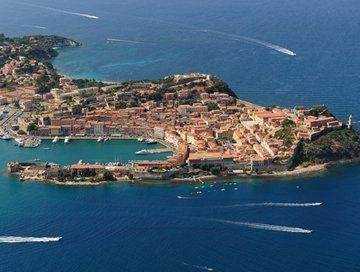Demonym(s) Portoferraiesi Local time Friday 6:36 PM | Elevation 4 m (13 ft) | |
 | ||
Frazioni Acquaviva, Biodola, Magazzini, Montecristo, San Giovanni, San Martino, Santo Stefano, Scaglieri, Schiopparello, Valle di Lazzaro, Viticcio, Volterraio Weather 16°C, Wind S at 11 km/h, 76% Humidity Points of interest Elba, Montecristo, Museo Nazionale Delle Res, Napoleonic Mills House, Capo Bianco | ||
Portoferraio is a town and comune in the province of Livorno, on the edge of the eponymous harbour of the island of Elba. It is the island's largest city. Because of its terrain, many of its buildings are situated on the slopes of a tiny hill surrounded on three sides by the sea.
Contents
- Map of 57037 Portoferraio Province of Livorno Italy
- History
- The Jewish Community
- Main sights
- Portoferraio lighthouse
- References
Map of 57037 Portoferraio, Province of Livorno, Italy
History
It was founded by Cosimo I de' Medici, Grand Duke of Tuscany, in 1548, with the name of Cosmopoli ("Cosimo's City"), to balance the presence of the Spanish citadel in Porto Azzurro. It had three forts (Forte Stella, Forte Falcone and Forte Inglese) and a massive line of walls, all still visible today.
The city remained to the Grand Duchy of Tuscany until the 18th century, when, due to its strategic position, it was contended by France, England and Austria. A British garrison withstood the Siege of Porto Ferrajo in 1801, but the 1802 Treaty of Amiens transferred the town to France. In 1814 it was handed over to Napoleon Bonaparte, as the seat of his first exile. In the 19th century, the city grew quickly, due to the construction of infrastructures and the exploitation of new iron mills in Rio Marina. Portoferraio then became the main shipping port of the ore towards the mainland, whence the current name, meaning "Iron Port" in Italian. After the end of the Napoleonic Era, Portoferraio returned to Tuscany, and became part of the Kingdom of Italy in 1860. Here brigand Carmine Crocco was imprisoned until his death for his revolution against the reign of Victor Emmanuel II and the anarchist Giovanni Passannante who attempted to kill king Umberto I.
During World War II, Portoferraio became the scene of battle when Elba was occupied by German forces. In late June 1944, an Allied force composed mainly of Free French troops liberated the island in a fight which lasted two days. Portoferraio was taken by French troops on 18 June, but was damaged by the fighting and the bombing raids which preceded the invasion.
Portoferraio's economy suffered from the end of mining activities starting from the 1970s, but in the following decades it gained a status as an internationally renowned tourist resort.
The Jewish Community
The first Jews arrived in Portoferraio at the beginning of the 17th century following the publication of the edict of 1556 in which Cosimo I de' Medici granted special privileges to all those who settled in Cosmopoli. In 1593, Ferdinando I de' Medici issued letters of patent, called La Livornina, by which more privileges were granted to foreign merchants, Jews in particular, who were willing to settle in the new free ports on Elba and in Leghorn.
Main sights
The town center is crowded around the small marina drawn in a natural cove.
Main points of interest include:
Portoferraio lighthouse
The lighthouse is placed on the northern rampart of Forte Stella built in 1548 from Cosimo I de' Medici. It was built by Leopod II Grand Duke of Tuscany in 1788; the stone tower is 25 metres high and has a double balcony and lantern. The lighthouse is fully automated, operated by Marina Militare and identified by the code number 2072 E.F.; the lantern is at 63 metres above sea level and emits a group of three white lightning strikes in a 14 seconds period visible up to 16 nautical miles. On the same tower is an additional light identified by the number 2072.2.E.F. that emits a red fixed light at 60 metres above sea level.
